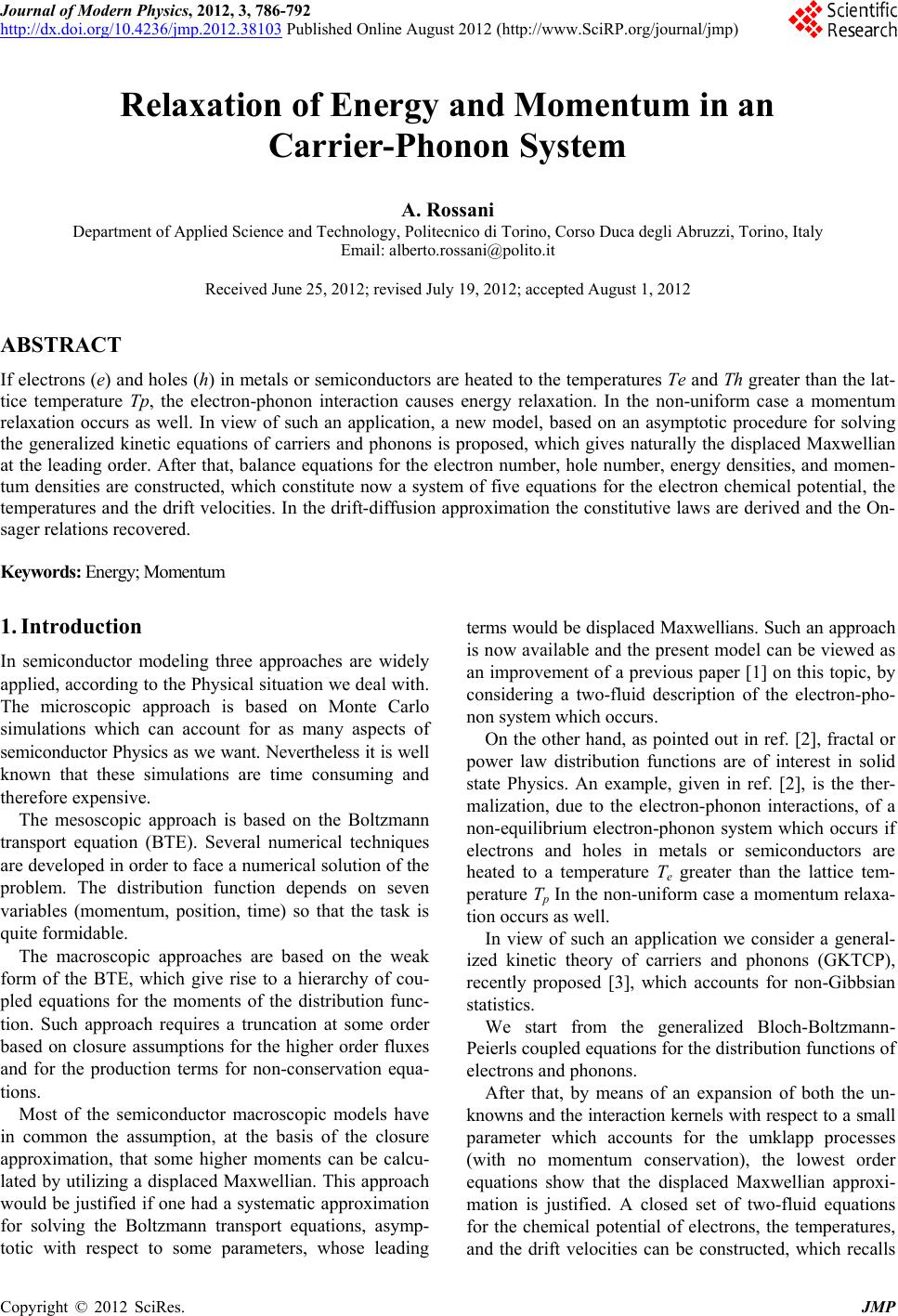 Journal of Modern Physics, 2012, 3, 786-792 http://dx.doi.org/10.4236/jmp.2012.38103 Published Online August 2012 (http://www.SciRP.org/journal/jmp) Relaxation of Energy and Momentum in an Carrier-Phonon System A. Rossani Department of Applied Science and Technology, Politecnico di Torino, Corso Duca degli Abruzzi, Torino, Italy Email: alberto.rossani@polito.it Received June 25, 2012; revised July 19, 2012; accepted August 1, 2012 ABSTRACT If electrons (e) and holes (h) in metals or semiconductors are heated to the temperatures Te and Th greater than the lat- tice temperature Tp, the electron-phonon interaction causes energy relaxation. In the non-uniform case a momentum relaxation occurs as well. In view of such an application, a new model, based on an asymptotic procedure for solving the generalized kinetic equations of carriers and phonons is proposed, which gives naturally the displaced Maxwellian at the leading order. After that, balance equations for the electron number, hole number, energy densities, and momen- tum densities are constructed, which constitute now a system of five equations for the electron chemical potential, the temperatures and the drift velocities. In the drift-diffusion approximation the constitutive laws are derived and the On- sager relations recovered. Keywords: Energy; Momentum 1. Introduction In semiconductor modeling three approaches are widely applied, according to the Physical situation we deal with. The microscopic approach is based on Monte Carlo simulations which can account for as many aspects of semiconductor Physics as we want. Nevertheless it is well known that these simulations are time consuming and therefore expensive. The mesoscopic approach is based on the Boltzmann transport equation (BTE). Several numerical techniques are developed in order to face a numerical solution of the problem. The distribution function depends on seven variables (momentum, position, time) so that the task is quite formidable. The macroscopic approaches are based on the weak form of the BTE, which give rise to a hierarchy of cou- pled equations for the moments of the distribution func- tion. Such approach requires a truncation at some order based on closure assumptions for the higher order fluxes and for the production terms for non-conservation equa- tions. Most of the semiconductor macroscopic models have in common the assumption, at the basis of the closure approximation, that some higher moments can be calcu- lated by utilizing a displaced Maxwellian. This approach would be justified if one had a systematic approximation for solving the Boltzmann transport equations, asymp- totic with respect to some parameters, whose leading terms would be displaced Maxwellians. Such an approach is now available and the present model can be viewed as an improvement of a previous paper [1] on this topic, by considering a two-fluid description of the electron-pho- non system which occurs. On the other hand, as pointed out in ref. [2], fractal or power law distribution functions are of interest in solid state Physics. An example, given in ref. [2], is the ther- malization, due to the electron-phonon interactions, of a non-equilibrium electron-phonon system which occurs if electrons and holes in metals or semiconductors are heated to a temperature Te greater than the lattice tem- perature Tp In the non-uniform case a momentum relaxa- tion occurs as well. In view of such an application we consider a general- ized kinetic theory of carriers and phonons (GKTCP), recently proposed [3], which accounts for non-Gibbsian statistics. We start from the generalized Bloch-Boltzmann- Peierls coupled equations for the distribution functions of electrons and phonons. After that, by means of an expansion of both the un- knowns and the interaction kernels with respect to a small parameter which accounts for the umklapp processes (with no momentum conservation), the lowest order equations show that the displaced Maxwellian approxi- mation is justified. A closed set of two-fluid equations for the chemical potential of electrons, the temperatures, and the drift velocities can be constructed, which recalls C opyright © 2012 SciRes. JMP 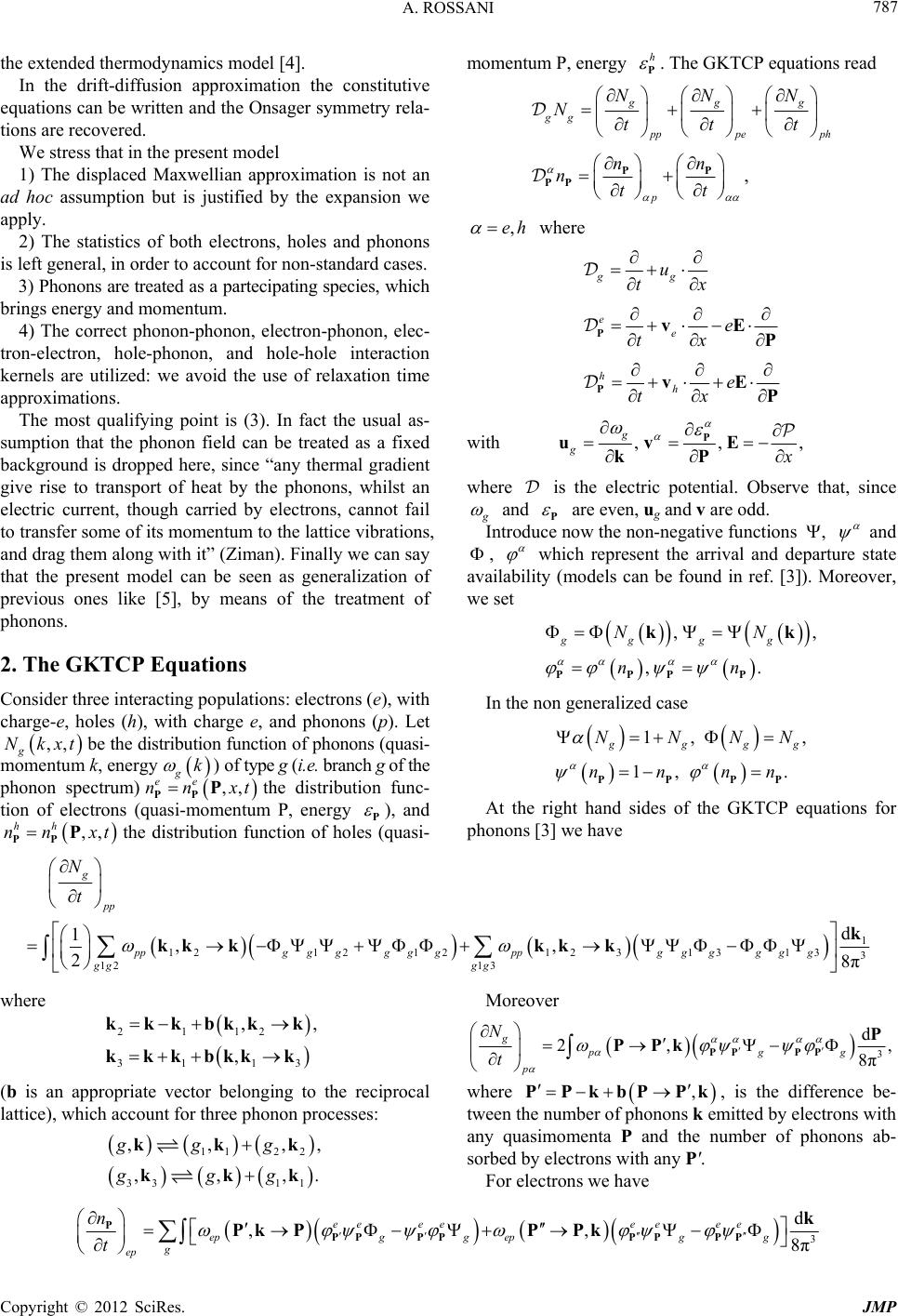 A. ROSSANI 787 the extended thermodynamics model [4]. In the drift-diffusion approximation the constitutive equations can be written and the Onsager symmetry rela- tions are recovered. We stress that in the present model 1) The displaced Maxwellian approximation is not an ad hoc assumption but is justified by the expansion we apply. 2) The statistics of both electrons, holes and phonons is left general, in order to account for non-standard cases. 3) Phonons are treated as a partecipating species, which brings energy and momentum. 4) The correct phonon-phonon, electron-phonon, elec- tron-electron, hole-phonon, and hole-hole interaction kernels are utilized: we avoid the use of relaxation time approximations. The most qualifying point is (3). In fact the usual as- sumption that the phonon field can be treated as a fixed background is dropped here, since “any thermal gradient give rise to transport of heat by the phonons, whilst an electric current, though carried by electrons, cannot fail to transfer some of its momentum to the lattice vibrations, and drag them along with it” (Ziman). Finally we can say that the present model can be seen as generalization of previous ones like [5], by means of the treatment of phonons. 2. The GKTCP Equations Consider three interacting populations: electrons (e), with charge-e, holes (h), with charge e, and phonons (p). Let g be the distribution function of phonons (quasi- momentum k, energy ,,Nkxt g ) of type g (i.e. branch g of the phonon spectrum) k ,, extP the d e nn PP istribution func- tion of electrons (quasi-momentum P, energy P), d h n PP istribution function of holes (quasi- an h ,, h n xPt the d momentum P, energy P. The GKTCP equations read , ggg gg ppeph p NNN Nttt nn ntt PP PP ,eh where gg e e h h u tx e tx e tx P P vE P vE P with ,,, g g P uvE kP where is the electric potential. Observe that, since and P Introduce now the non-negative functions are even, ug and v are odd. and , , which represent the arrival and departure state availability (models can be found in ref. [3]). Moreover, we set ,, ,. gg gg NN nn PPP P kk In the non generalized case 1, , 1, . ggg NNNN nnnn PPPP At the right hand sides of the GKTCP equations for phonons [3] we have 1 121 21231 3133 13 d ,, 8π pp pp gggg ggppgggg gg gg gg k kk kkk k where 2112 13 ,, , kkkbkk k bkkk belonging to the reciprocal 11 ,.gkkk Moreover 12 12 1 2 g t N 31 kkk (b is an appropriate vector 33 ,,gg lattice), which account for three phonon processes: 112 2 ,,,,gggkkk 3 d 2, , 8π pg g p t PPPP P PPk where g N , PPkbPPk , is the difference be- tween the number of phononk emitted by electrons with asimomenta P and the n s any quumber of phonons ab- sorbed by electrons with any P'. For electrons we have 3 d ,, 8π ee eeee epg gg g g ep t PP PPPP k Pk P e e ep PP P Pk n P Copyright © 2012 SciRes. JMP 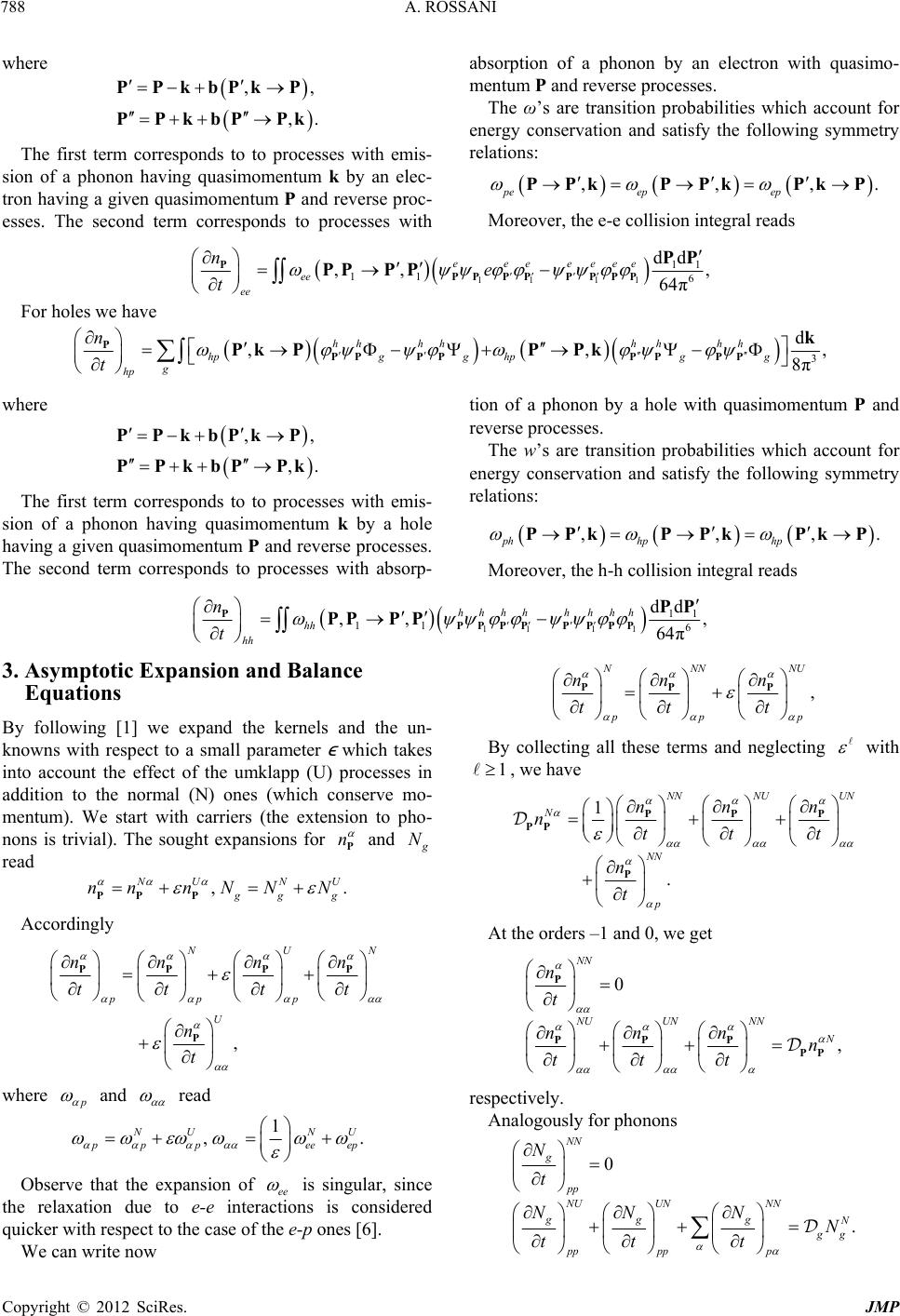 A. ROSSANI 788 where ,, ,. bPk P bP Pk The first term corresponds to to processes with emis- sion of a phonon having quasimomentum k by an elec- tron having a given quasimomentum P and reverse proc- es absorption of a phonon by an electron with quasimo- mentum P and reverse processes. The ω’s are transition probabilities which account for PPk PPk ses. The second term corresponds to processes with energy conservation and satisfy the following symmetry relations: ,,,. pe ep ep P PkP PkPkP Moreover, the e-e collision integral reads 1 11 dd , eeeeeee e PPP For holes we have 111 6 64 π PPPPPP11 ,, ee ee n t PP PP P P 3 d ,,, 8π hhhhh hh hpgg hpgg n PPPPPPPPPk Pk PPPk ,, ,. PPkbPk P PPkbP Pk The fi sion of having a tion of a phonon by a hole with quasimoment P and reverse processes. The w’s are transition probabilities which account for ral reads h g hp t where rst term corresponds to to processes with emis- a phonon having quasimomentum k by a hole given quasimomentum P and reverse processes. Th er, the h-h collision integ e second term corresponds to processes with absorp- um energy conservation and satisfy the following symmetry relations: ,,,. ph hp hp PPkPPkPkP Moreov 1111 6, 64 π PPPPPP 11 dd hhhhh hhh PP PP 3. Asymptotic Expansion and Balance the un- h takes inteffect of the umklapp (U) processes in 11 ,, hh hh n t PPP P P Equations , NNN NU pp nn n tt t PP P By following [1] we expand the kernels and knowns with respect to a small parameter ϵ whic o account the addition to the normal (N) ones (which conserve mo- mentum). We start with carriers (the extension to pho- nons is trivial). The sought expansions for n P and N read ,. UNU gg nnnNN N PP P Accordingly , UN p nn nn t t p tp U tt n PP PP P where and read 1 ,. UNU pp peeep Observe that the expansion of ee is singular, since the relaxation due to e-e interactions is considered quicker with respect to the case of the e-p ones [6]. We can write now By collecting all these terms and neglecting with 1, we have 1 . NNUUN N NN p nnn ntt t n t PP PP At the orders –1 and 0, we get P P 0 , NN NU UNNN N n t nnnn t P PPP PP respectively. Analogously for phonons tt 0 . NN g pp NU UNNN g gg g p N t NNN N t pp pp tt Copyright © 2012 SciRes. JMP 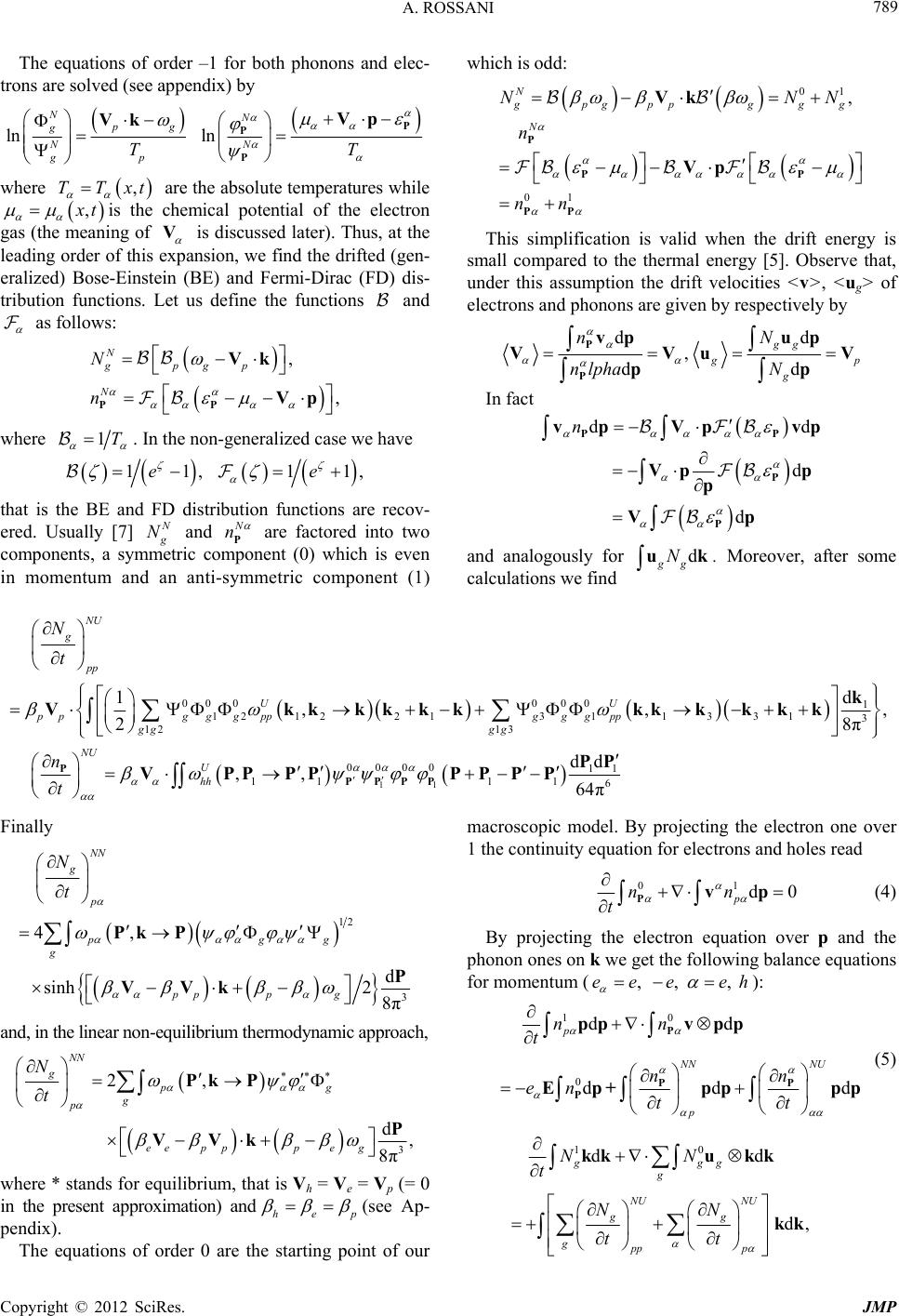 A. ROSSANI 789 The equations of order –1 for both phonons and elec- trons are solved (see appendix) by ln ln NN pg g NN p g TT P Vp P P Vk where ,TTxt are the absolute temperatures while , t is the chemical potential of the electron gas (the meaning of V is discussed later). Thus, at the er of this expansion, we find the drifted (gen -Einstein (BE) and Fermi-Dirac (FD) dis nctions. Let us define e functions and leading eralized) Bose tributio ord n fu - - th as , , N gpgp N N n follows: PP Vk Vp where 1T . In the non-generalized case we have 11, 11,ee that is the BE and FD distribution functions are recov- ered ually . Us [7] N and n P are factored into two nts, a entum a) componemetric component (0) which is even in momnd an anti-symmetric component (1 sym which is odd: 01 01 , N gpgpp ggg N NNN n nn P PP PP Vk Vp This simplification is valid when the drift energy is small compared to the thermal energy [5]. Observe that, under this assumption the drift velocities <v>, <ug> of electrons and phonons are given by respectively by dd , dd gg p g nN nlpha N P P vp up VVuV pp In fact dd d d n PP P P vp Vpvp Vp p p Vp d gg N uk and analogously for . Moreover, after some calculations we find 00 0 12122 1 1, 2 g pp U pp g ggpp N t Vk kkkk 0 001 31133 13 12 13 d , , 8π NU U gg gpp gg gg k kkkkkkk 11 0 00011 11 11 6 dd ,, 64 π NU U hh n t PP PPPPP VPPPP PPPP Finally 12 3 4, d 28π NN g p pgg p g N t Pk P P ermodynamic approach, macroscopic model. By projecting the electron one over 1 the continuity equation for electrons and holes read sinh pp VV k and, in the linear non-equilibrium th g 3 8π ee p ppeg 2, d , NN g pg N t PkP P VVk where * stands for equilibrium, that is V = V = V (= 0 g p hep in the present approximation) and he p (see Ap- pendix). The equations of order 0 are the starting point of our 01 d0 p t nn Pvp (4) By projecting the electron equation over p and the phonon ones on k we get the following balance equations for momentum (, , , eee eh ): 10 dd p NN NU nn t t P ppv pp (5) 0ddd p nn en t PP P Ep + pppp 10 dd ggg g NU NU NN t NN kku kk d, gg gpp p tt kk Copyright © 2012 SciRes. JMP 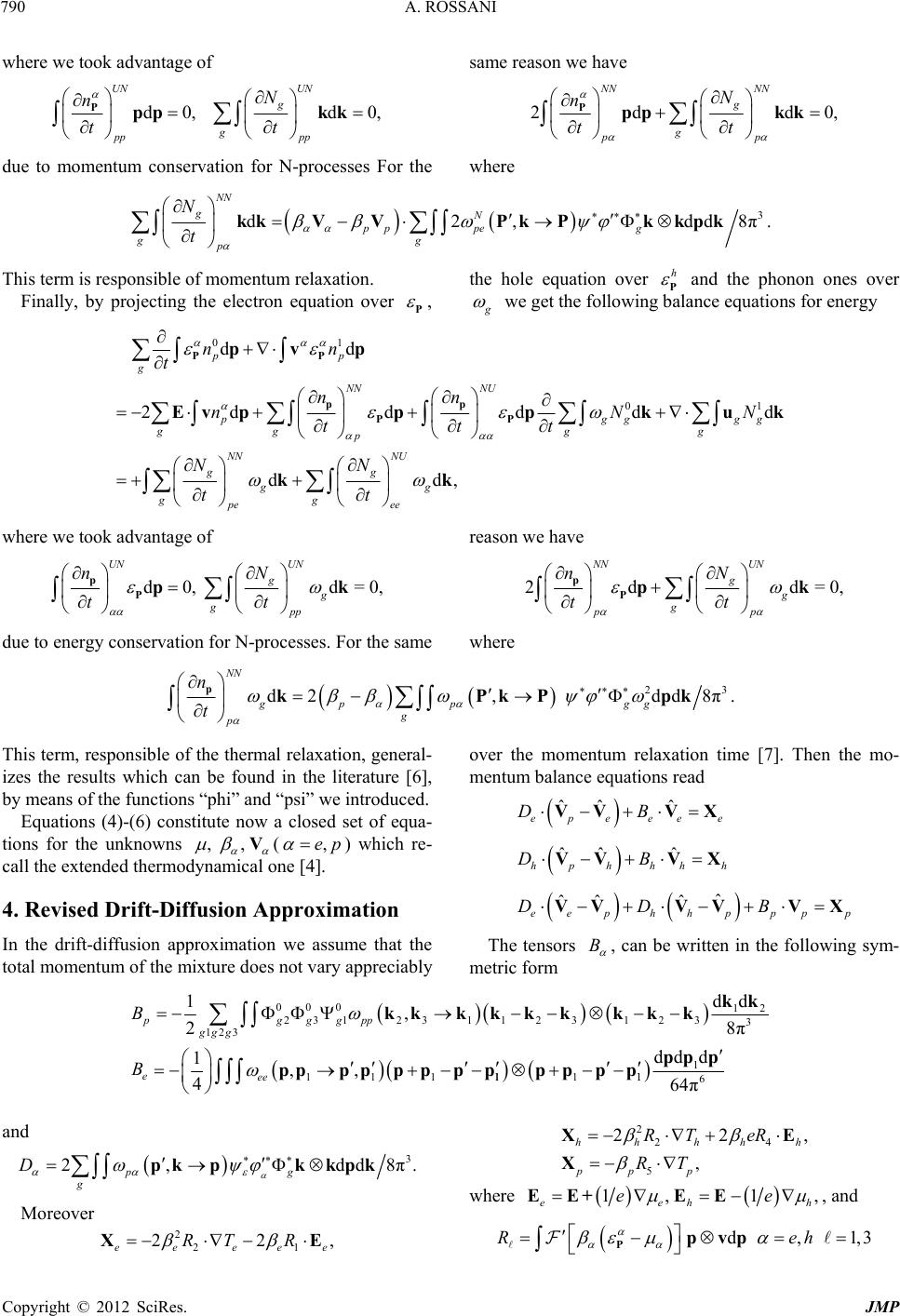 A. ROSSANI 790 where we took advantage of d0, d0, g gpp pp tt Pppkk due to momentum-p UN UN N n conservation for Nrocesses For the same reason we have 2d d0, NN NN g N n gp p tt Pppkk where 3 d2,dd8π. NN N pp peg gg VVPkPkkpk m relaxation. Finally, by projecting the electron equation over g p N t kk This term is responsible of momentu , ion over h P the hole equat P and the phonon ones over we get the following balance equations for energy 01 dd 01 2d dddd dd pp g NU pgg gg ggg g p NN NU g gg pe ee nn t nn nNN ttt N tt PP pp PP pv p Ev pppkuk kk where we took advantage of , NN g N gg d0, d=0, g gpp tt Ppk UN UN g nN p due to energy conservation for N-processes. For the same reason we have 2d d=0, NN UN g g g pp nN tt pPpk where 23 d2, dd8π. NN gp pgg g p n t pkPkPpk This term, responsible of the thermal relaxation, general- izes the results which can be found in the literature [6], introduced. osed set of equa- by means of the functions “phi” and “psi” we now a cl , Equations (4)-(6) constitute tions for the unknowns , V(,ep ) which re- 4. Revised Drift-Diffusion Approximation not vary appreciably over the momentum relaxation time [7]. Then the mo- mentum balance equations read call the extended thermodynamical one [4]. ˆˆ ˆ ˆˆ ˆ ˆˆ ˆˆ eee e hphhh h ee phh pppp DB DB DDB VV VX VV VX VVVVV X ensors B In the drift-diffusion approximation we assume that the total momentum of the mixture does ep The t , can be written in the following sym- metric form 000 12 23123112 312 33 12 3 111116 dd , 28π 64 π pgggpp gg g B kk kkkk kkk kk p pppp p1 dd d pp p 11 1 1,, 4 eee B p ppppp 1 and 3 dd8π. g pk 2 24 5 22, , hhhhh pp p RT eR RT XE X where 2, pg D pkpk k Moreover 2 21 22, ee eee RTR XE 1, 1, eehh ee EE+ EE, and d,1,3Reh Ppvp Copyright © 2012 SciRes. JMP 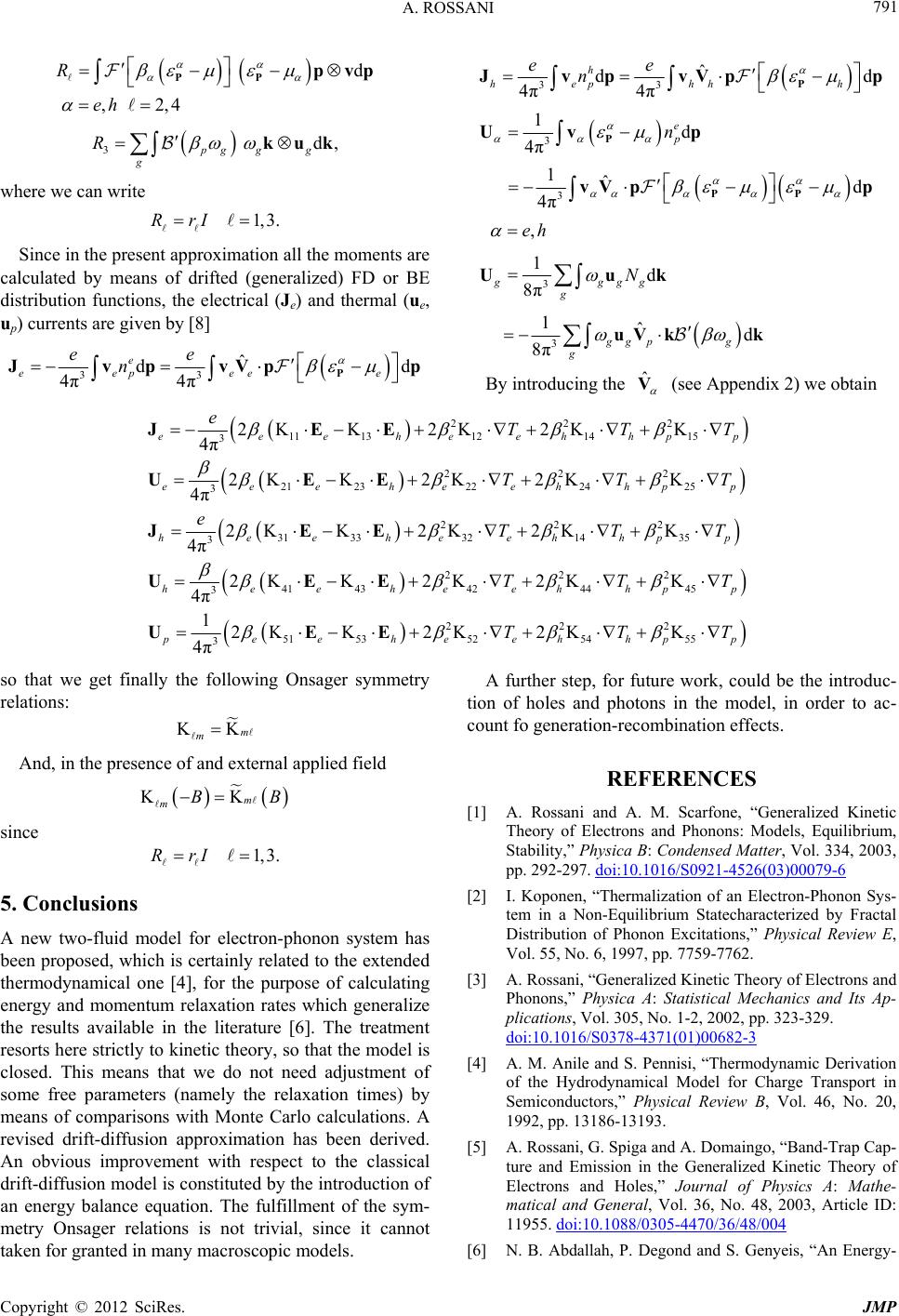 A. ROSSANI 791 dR PP pvp ,2,4eh d, g g kuk where we can write 1, 3.RrI Since in the present approximation all the moments are calculated by means of drifted (generalized) FD or BE distribution functions, the electrical (Je) and thermal (ue, up) currents are given by [8] 3pg g R dd e Pp 33 ˆ 4π4π e eepee ee n JvpvVp 3 3 3 3 3 dd 4π 1d 4π 1ˆ d 4π , 1d 8π 1ˆ d 8π h ephhh e p gggg g gg pg g n n eh N P P PP p Uv p vV pp Uuk uV kk ˆ 3ˆ 4π h ee Jv vVpp By introducing the V (see Appendix 2) we obtain 222 131214 15 222 232224 25 222 33321435 3 2K K2K2KK 4π 2K K2K2KK 4π 2K K2K2KK 4π 2K K2 4π eeeheehhpp eeeheehhpp heeheehhpp hee eTTT TTT eTTT JEE UEE JEE UE 11 3 21 3 31 3 41 43 h E 222 424445 222 51 53525455 3 K2K K 12K K2K2KK 4π eehhpp eeheeh hp p TTT TTT UEE so that we get finally the following Onsager symmetry relations: KK m m And, in the presence of and external applied field KK m mBB ew two-fluid model for electron-phonon system has proposed, which is certainly related to the extended odynamical one [4], for the purpose of calculating gy and momentum relaxation rates which generalize e results available in the literature [6]. The treatment [1] A. Rossani and A. M Theory of Electrons and Stability,” Physica B: pp. 292-297. since A n been therm ener th resorts here strictly to kinetic theory, so that the model is closed. This means that we do not need adjustment of some free parameters (namely the relaxation times) by means os with Monte Carlo calculations. A revised n approximation has been derived. An obvious improvement with respect to the classical driftnstituted by the introduction of ny macroscopic models. A further step, for future work, could be the introduc- tion of holes and photons in the model, in order to ac- count fo generation-recombination effects. REFERENCES ic Phonons: Models, Equilibrium, Condensed Matter, Vol. 334, 2003, doi:10.1016/S0921-4526(03)00079-6 1, 3.RrI 5. Conclusions f comparison drift-diffusio -diffusion model is co an energy balance equation. The fulfillment of the sym- metry Onsager relations is not trivial, since it cannot taken for granted in ma . Scarfone, “Generalized Kinet rmalization of an Electron-Phonon Sys- quilibrium Statecharacterized by Fractal Phonon Excitations,” Physical Review E, . 7759-7762. ized Kinetic Theory of Electrons and : Statistical Mechanics and Its Ap- 305, No. 1-2, 2002, pp. 323-329. /S0378-4371(01)00682-3 [2] I. Koponen, “The tem in a Non-E Distribution of Vol. 55, No. 6, 1997, pp [3] A. Rossani, “General Phonons,” Physica A plications, Vol. doi:10.1016 [4] A. M. Anile and S. Pennisi, “Thermdynamic Derivation of the Hydrodynamical Model for Charge Transport in Semiconductors,” Physical Review B, Vol. 46, No. 20, 1992, pp. 13186-13193. [5] A. Rossani, G. Spiga and A. Domaingo, “Band-Trap Cap- ture and Emission in the Generalized Kinetic Theory of Electrons and Holes,” Journal of Physics A: Mathe- matical and General, Vol. 36, o. 48, 2003, Article ID: 11955. doi:10.1088/0305-4470//48/004 o N 36 [6] ergy- N. B. Abdallah, P. Degond and S. Genyeis, “An En Copyright © 2012 SciRes. JMP 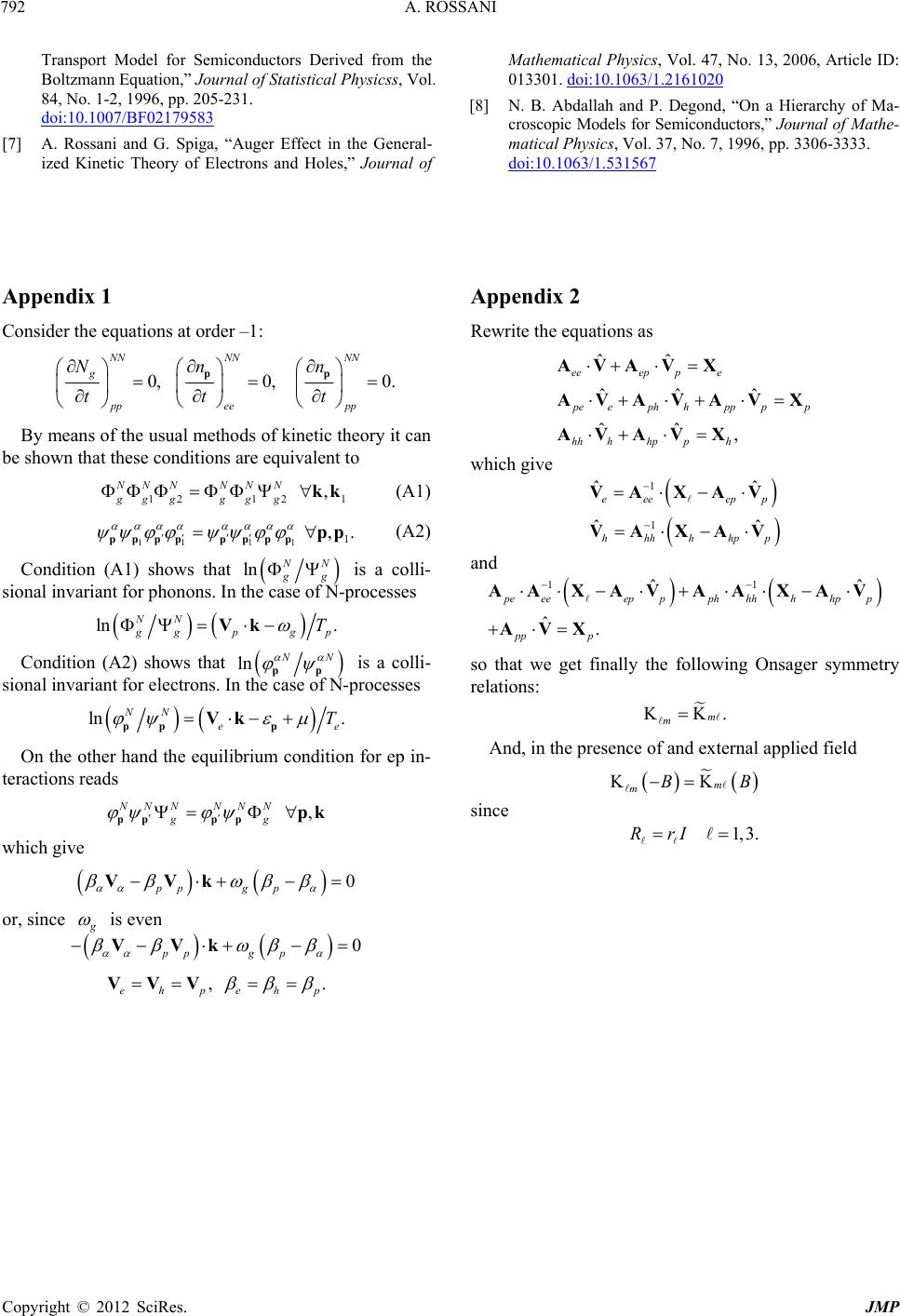 A. ROSSANI 792 Transport Model for Semiconductors Derived from the Boltzmann Equation,” Journal of Statistical Physicss, Vo 4, No. 1-2, 1996, pp. 205-231. /BF02179583 l. 8 doi:10.1007 [7] A. Rossani and G. Spiga, “Auger Effect in the General- eory of Electrons and Holes,” Journal of ized Kinetic Th Mathematical Physics, Vol. 47, No. 13, 2006, Article ID: 013301. doi:10.1063/1.2161020 [8] N. B. Abdallah and P. Degond, “On a Hierarchy of Ma- croscopic Models for Semiconductors,” Journal of Mathe- matical Physics, Vol. 37, No. 7, 1996, pp. 3306-3333. doi:10.1063/1.531567 Appendix 1 Consider the equations at order –1: 0, 0, 0. NN NNNN g pp eepp Nn n ttt pp By means of the usual methods of kinetic theory it can be shown that these conditions are equivalent to 12121 , NN NNN N gg ggg g kk (A1) 11111 ,. pppppppp pp (A2) Condition (A1) shows that ln NN gg is a colli- sional invariant for phonons. In the case of N-processes ln . NN gpg Vk p T Condition (A2) shows that ln pp is a colli- sional invariant for electrons. In the case of N-processes N N ln NN pp Vk . ee T p On the other rium condition for ep in- ractions reads , NN gg ppk 0 g p hand the equilib te NN NN pp p which give VVk pp or, since is even 0 ppg p VVk , . eh pehp VVV Appendix 2 Rewrite the equations as ˆˆ ˆˆˆ ˆˆ , eeeppe eephhpp pp hh hhpph AVAV X AVAVAV X AVAVX which give 1 1 ˆˆ ˆ eee epp hhh VA XAV VA XA ˆ hhpp V and 11 ˆˆ ˆ. e eeep pphhhhhp p AA XAVAAXAV AVX pp p so that we get finally the following Onsager symmetry relations: KK. m m And, in the presence of and external applied field KK m mBB since 1, 3.RrI Copyright © 2012 SciRes. JMP
|